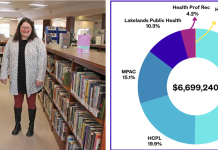The Coalition for Equitable Water Flow (CEWF) says water levels in area reservoir lakes are near normal right now, but will be changing over the next couple of weeks – much earlier than usual.
Chair Ted Spence said, “CEWF is attentive to the noteworthy combination of a very low snowpack, subnormal winter precipitation, and unseasonable temperatures.”
CEWF said recent surveys have shown the snowpack in the watersheds is less than 60 per cent of normal in northern areas, and ranging down to near zero per cent further south.
Additionally, total precipitation has been below normal each month since September 2023, and in February was just 35 per cent of normal in the Haliburton area of the reservoir system. Since the Haliburton Highlands is the headwaters of the reservoir system, this combination of factors is impactful to the entire system, CEWF said last week.
“The TSW recognized this developing situation early and has been adding logs to reservoir dams. By the end of February, almost all reservoir dams have had logs added to store water and reduce the risk of very low spring water levels,” Spence said.
As a result of the early logging operations, CEWF predicts most lakes will see a slow rise, however flow-through lakes will see lower levels, and river flows will be reduced.
“As lake levels rise, changes in ice conditions may include breaking up and away from the shore and creating a risk of shoreline ice damage, particularly under high winds,” Spence said. “CEWF advises property owners to be attentive to changing conditions via local news, municipal channels or its website at cewf.ca.”
While logging operations this early is unusual, CEWF said, “the TSW has been proactive on behalf of the reservoir lakes. TSW staff continually monitor weather forecasts, lake levels and flows in their daily evaluation of options. Their future actions, as well as the vulnerability of the spring season, will depend on melt and rainfall events over the next two months.
“We’re going to need a lot of rain,” Spence added. He said despite the weekend rain event, we did not get as much precipitation as predicted.
In the TSW’s water level management update of March 8 for Haliburton and northern areas, it said the Haliburton and Northern Peterborough County reservoirs are above average due to earlier than typical snowmelt. It said the low amounts of snowpack remain in the most northern watersheds of the system.
“Lake levels are monitored daily and assessed in relation to estimated runoff amounts, however they are susceptible to changes in response to the future precipitation amounts.”
The TSW added flows on the Gull and Burnt River were expected to rise as a result of this past Saturday’s rain and saturated soil conditions.
Fire season
Meanwhile, Dysart et al fire chief Dan Chumbley said “definitely things are drying up… or seem to be drying up a lot faster.”
He said he’d already had people calling him and commenting on how dry the bush is.
“We usually have snow on the ground. It looks like the ice is going to be out by the end of March, when it’s usually the end of April.”
He said it’s too early for MNRF daily notices, and for the township fire chiefs to discuss fire bans but “it’s not too early to be worrying about it. We are conscious of it and thinking about it.”
Meanwhile, the four townships are working on a new burn bylaw before the official MNRF burn season.
It will mean not having any daytime burning permits available.





